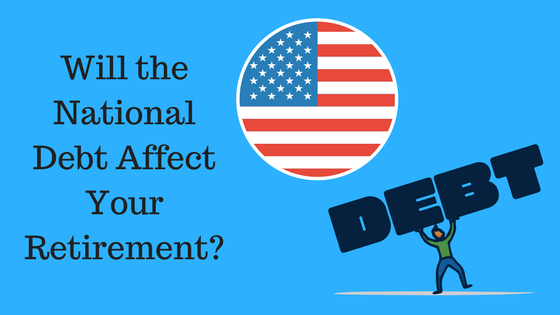
Every minute, the United States’ national debt is climbing and climbing with no end in sight. The national debt is currently over $20 trillion. If you can’t quite fathom how large of a number that is, it’s 20,000 billion, or 20,000,000 million. To put it into perspective, that’s more than $170,000 for each and every tax payer.
This number has increased over 150% since 2004. With the passage of the new tax plan, current projections place the national debt at more than $21 trillion by 2019. Oh, and that doesn’t count any unfunded liabilities, which is money the government hasn’t actually borrowed yet, but has promised to pay far in the future. Nor does it count state, county, or city governments, many of which have debts in the hundreds of millions or billions of dollars themselves.
What, if anything, do the astronomical sums mean for your retirement?
A high national debt tends to keep inflation low. As a result, your money won’t lose its purchasing power as quickly, so you won’t have to overcompensate by saving more in retirement than you’ll need at first. Unfortunately, a direct consequence of this is that it also keeps interest rates down.
Since the government has to pay interest on the money it has borrowed, they must keep rates as low as possible to avoid a default. When is the last time you saw a 5% yield on a savings account? Rates on bonds are next to nothing. This is not so good for savers who have few options to achieve a safe return on their money.
Low interest rates can help companies that are looking to borrow and expand. However, with so many of the overall economy’s resources tied up in government spending, debt, and interest payments, it’s a massive strain on economic growth. This is great news if you’re young and not planning on retiring for another 30 years. It’s bad news, if you’d like to retire in the near future.
Without economic growth, there is little incentive to borrow and invest except to buy back stock and pay dividends. This creates the appearance of growth without actually doing any work. This is the economic “recovery” you’ve been living in for the past eight years.
Many financial “experts” believe that the current national debt does not impact the stability of the economy:
1. The US can afford to service its debt
While the total debt outweighs total U.S. gross domestic product (GDP), the interest on the debt is only 1.5% of GDP. Just like with your credit cards, the U.S. can easily afford to make the minimum payments on their balance. Of course, this means the debt is always growing since there is no principal paydown, but the government certainly has the ability to keep kicking the can down the road.
● At the current GDP, the annual debt service would have to triple to nearer 5% to become an issue of making payment. In the long run, only paying the interest will eventually lead to catastrophe.
2. US citizens and corporations own the majority of the debt
American creditors own two-thirds of the debt. Which means, we owe all the money to ourselves! Most of the interest paid stays in the United States. You may have heard that China owns a lot of US debt, however there portion is only hovering at around 6%.
3. The government can always issue new debt to pay back old debt
But that’s only as long as there is a buyer for the new debt issue and the interest payments aren’t rising. This method of “rolling over” the debt is common practice. Were buyers of U.S. debt to dry up because of a credit downgrade or another financial crisis, the Federal Reserve can always print money to “monetize” or buy the new debt issues. This would of course massively devalue the currency and could lead to hyperinflation, but at least the government can say that they “always pay their bills”, even if the money used to pay them is worthless.
Spending less and saving more has never been more important. Learn to live on less or ways to make more and you’ll be able to weather any coming financial storms. Unfortunately, the result of low interest rates and high government debt is that often the only option is to take on riskier investments. Don’t fall into the trap of chasing yield. Make slow and steady investments in sound companies, real estate, or a small business of your own.




No comments yet.